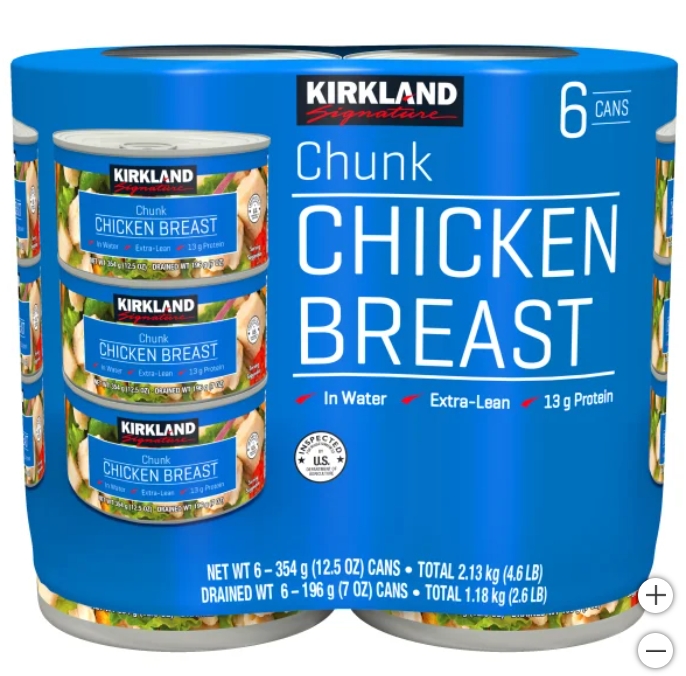
Kirkland Signature, Chicken Breast, 12.5 oz, 6-Count
- Chunk Chicken Breast
- Packed in Water
- Good Source of Protein
- Net Weight 75 oz
- Product of USA
Transforming Everyday Meals with Costco’s Hidden Gem
When it comes to versatile pantry staples that can rescue weeknight dinners, few products deserve more recognition than the humble can of chicken. I’ll admit it: for years, I was a canned chicken skeptic. That changed the day I reluctantly added a pack of Kirkland Signature Canned Chicken to my overflowing Costco cart. Little did I know this unassuming product would revolutionize my meal prep routine and become what I now consider the most versatile protein source in my kitchen arsenal.
Whether you’re a longtime fan or a curious newcomer, this comprehensive guide will take you through everything you need to know about Kirkland Canned Chicken—from ingredients and nutrition to creative recipes and money-saving tips. So let’s pop the lid on this pantry powerhouse and discover why it deserves prime real estate in your kitchen.
What Exactly Is in That Can? Ingredients Breakdown
The beauty of Kirkland Canned Chicken lies in its simplicity. Unlike many processed foods with ingredient lists that read like chemistry experiments, Kirkland keeps it refreshingly straightforward. Each can contains just four ingredients: chicken breast meat, water, salt, and a touch of chicken broth for flavor.
The star of the show is, of course, the chicken itself—premium chunks of white breast meat that maintain their texture surprisingly well through the canning process. Kirkland sources their chicken from reputable farms that meet Costco’s strict quality standards. The absence of fillers, artificial preservatives, or mystery additives is particularly noteworthy in today’s food landscape where clean labels are increasingly rare.
For those with dietary concerns, you’ll be pleased to know that Kirkland Canned Chicken is completely gluten-free. This makes it an excellent protein option for those with celiac disease or gluten sensitivity. The product is also free from added MSG, artificial colors, and flavors—making it a relatively clean protein source compared to many convenience foods.
Cooking Status: Ready When You Are
One of the greatest advantages of Kirkland Canned Chicken is that it’s fully cooked right out of the can. In our busy lives where time is increasingly precious, having a protein source that requires zero cooking time is nothing short of revolutionary.
This pre-cooked status means you can use it in cold preparations like salads and sandwiches without any additional steps. For hot dishes, you simply need to heat it through—no need to worry about hitting specific internal temperatures or dealing with raw meat contamination concerns. This makes it particularly valuable for quick lunches, impromptu meals, or those nights when cooking feels like an insurmountable task.
The fully-cooked nature also makes it ideal for situations where cooking facilities are limited or unavailable—think college dorms, office lunches, camping trips, or power outages. It’s essentially ready-to-eat survival food that actually tastes good.
The Financial Breakdown: Is It Worth Your Costco Membership?
Let’s talk numbers. At Costco, Kirkland Canned Chicken typically comes in a pack of six 12.5-ounce cans, usually priced around $11.99 to $13.99, though prices may vary by location and over time. This breaks down to approximately $2.00-$2.33 per can or about $0.16-$0.19 per ounce.
When compared to fresh chicken breast (which can range from $2.99-$4.99 per pound), the canned version might initially seem more expensive. However, the calculation changes when you factor in:
- Zero waste—you’re using 100% of what you pay for, unlike fresh chicken with its trimmable parts
- Extended shelf life—no risk of forgetting it in the fridge and having to throw it out
- No shrinkage during cooking
- Time savings—your time has value too!
When viewed through this lens, Kirkland Canned Chicken represents solid value, especially for households that prioritize convenience without sacrificing quality. The bulk packaging at Costco further enhances the value proposition—another win for your wallet.
Health Considerations: Nutritional Profile Examined
Nutrition-conscious consumers often approach canned foods with skepticism, but Kirkland Canned Chicken might surprise you with its solid nutritional profile.
A typical 2-ounce serving (drained) contains approximately:
- 60 calories
- 1g fat (0.5g saturated)
- 290mg sodium
- 0g carbohydrates
- 13g protein
The protein content is the standout feature here—providing a substantial 13 grams per modest serving. This makes it an excellent option for those looking to increase their protein intake, including athletes, older adults, and anyone following a high-protein diet.
The fat content is minimal, which is good news for those monitoring their fat intake. However, the sodium level is worth noting. At 290mg per 2-ounce serving, it’s not the highest among canned proteins, but it’s not insignificant either. Those on sodium-restricted diets should factor this into their daily sodium calculations.
For those following specific dietary approaches, Kirkland Canned Chicken is naturally keto-friendly with zero carbohydrates. It’s also compatible with paleo and Whole30 diets, provided you’re comfortable with the minimal processing involved in canning.
Shelf Life: Your Emergency Meal Plan
One of the most compelling reasons to keep Kirkland Canned Chicken on hand is its impressive shelf life. Each can typically comes with a “best by” date approximately 3-5 years from production. This extended shelf life makes it an ideal emergency food supply component as well as a reliable pantry staple.
Even after opening, the remaining chicken stays fresh for 3-4 days when stored in an airtight container in the refrigerator. This flexibility means you can use exactly what you need without waste, making it particularly valuable for single households or small families.
The long shelf life also makes it economical to stock up during Costco sales, further enhancing its value proposition. I’ve personally maintained a rotating stock of 8-10 cans in my pantry, using and replacing them to ensure I always have this versatile protein at the ready.
Quality Considerations: How Does It Compare to Other Brands?
The canned chicken market isn’t particularly crowded, but there are several competitors to Kirkland’s offering. Having tried many of them in my kitchen experiments, I can confidently say that Kirkland consistently outperforms most competitors in several key areas:
- Chunk size – Kirkland provides larger, more identifiable pieces of chicken compared to the shredded or minced texture found in many other brands
- Moisture level – Neither too dry nor too watery, striking an ideal balance
- Flavor – A clean, natural chicken taste without overwhelming seasoning or “canned” notes
- Texture – Maintains a reasonable firmness without the mushiness that plagues some competitors
National brands like Swanson and Valley Fresh offer similar products, but typically at a higher price point without a noticeable quality advantage. Store brands may come close in price but often fall short in texture and chunk size.
The most comparable competitor is probably Bumble Bee Premium Chicken Breast, which offers similar quality but at a significantly higher price per ounce when not purchased in bulk.
Packaging Practicalities: Opening, Storing, and Using
Kirkland Canned Chicken comes in standard-sized cans with convenient pull-tab lids—no can opener required. This small detail makes a significant difference when you’re camping, traveling, or simply in a hurry. The ease of opening contributes to its versatility as an emergency food or on-the-go protein source.
After opening, you’ll notice the chicken is packed in its own broth. While some recipes call for using this broth, most applications benefit from draining the chicken first. A simple strainer does the job perfectly, and the drained chicken is then ready for immediate use.
For any unused portion, transfer to an airtight container rather than storing in the original can once opened. Glass containers work particularly well for maintaining freshness without imparting any metallic taste to the leftover chicken.
From Can to Table: Versatile Recipe Applications
The true magic of Kirkland Canned Chicken lies in its incredible versatility. Here are some of my favorite ways to transform this humble ingredient into delicious meals:
Quick Lunch Ideas
- Chicken Salad Extraordinaire: Mix drained chicken with Greek yogurt, diced apple, walnuts, dried cranberries, and a touch of curry powder for a gourmet chicken salad that tastes like it took hours.
- Mediterranean Wrap: Combine chicken with diced cucumber, tomato, feta cheese, olives, and tzatziki sauce in a whole grain wrap.
- Protein-Packed Mason Jar Salads: Layer chicken with greens, quinoa, roasted vegetables, and a lemon-olive oil dressing for grab-and-go lunches.
Dinner Solutions
- Shortcut Enchiladas: Roll chicken mixed with green chiles and cheese in corn tortillas, top with enchilada sauce and more cheese, then bake until bubbly.
- 15-Minute Chicken Alfredo: Toss chicken with cooked fettuccine, jarred Alfredo sauce, and steamed broccoli for a nearly instant comfort food fix.
- Quick Chicken Pot Pie: Mix chicken with frozen mixed vegetables and condensed cream of chicken soup, pour into a pie crust, top with another crust or biscuits, and bake until golden.
Entertaining Appetizers
- Buffalo Chicken Dip: Blend chicken with cream cheese, ranch dressing, hot sauce, and shredded cheese for a game day favorite.
- Chicken Quesadilla Triangles: Fill tortillas with chicken, cheese, and mild green chiles, cook until crispy, then cut into triangles and serve with salsa.
- Asian Chicken Lettuce Wraps: Sauté chicken with ginger, garlic, water chestnuts, and hoisin sauce, then serve in butter lettuce cups.
Soups and Stews
- 10-Minute Chicken Noodle Soup: Add chicken to simmering chicken broth with carrots, celery, onions, and egg noodles for an almost-instant comforting soup.
- White Chicken Chili: Combine chicken with white beans, green chiles, cumin, and chicken broth for a hearty alternative to traditional chili.
- Thai-Inspired Coconut Soup: Simmer chicken in coconut milk with lemongrass, ginger, lime juice, and a splash of fish sauce.
The beauty of these recipes is their adaptability. You can customize each one based on your preferences, dietary needs, and what you happen to have on hand. The time you save using pre-cooked chicken can be invested in personalizing flavors and adding fresh components that elevate the entire dish.
Special Dietary Considerations: Allergens and Restrictions
For those navigating dietary restrictions, Kirkland Canned Chicken is remarkably accommodating. As mentioned earlier, it’s naturally gluten-free, making it suitable for those with celiac disease or gluten sensitivity.
The product contains no dairy, eggs, nuts, or soy, avoiding many common allergens. The ingredient simplicity means it fits into most specialized diets with minimal concerns.
For those watching sodium intake, there are a few strategies to reduce the sodium content:
- Rinse the chicken thoroughly after draining
- Combine with fresh, unseasoned ingredients to dilute the overall sodium concentration in your meal
- Balance with potassium-rich foods like sweet potatoes or bananas
The product is not certified organic, which may be important to some consumers. However, Costco maintains that their Kirkland Signature poultry products come from animals raised without antibiotics, aligning with many consumers’ preference for more naturally raised animal products.
Sustainability and Sourcing: The Bigger Picture
While convenience is a major selling point, many consumers today are equally concerned about where their food comes from and its environmental impact. Costco maintains that their Kirkland Signature products must meet or exceed the quality of national brands, and this extends to sourcing practices.
The chicken used in Kirkland Canned Chicken is sourced from facilities that follow Costco’s animal welfare policies. The company has taken steps in recent years to improve the sustainability of their meat supply chain, including commitments to reduce antibiotics use in poultry.
The canning process itself has some environmental advantages over fresh chicken:
- Extended shelf life reduces food waste
- Ambient storage requires no refrigeration energy until opened
- Cans are widely recyclable in most communities
For those particularly concerned about environmental impact, using canned chicken strategically—perhaps as a backup protein rather than a daily staple—can be part of a balanced approach to sustainable eating.
What Real Users Say: The Consensus Among Reviewers
Consumer reviews of Kirkland Canned Chicken are overwhelmingly positive, with most praising its convenience, versatility, and quality. A pattern emerges when examining online reviews, with several consistent themes:
Positive comments frequently mention:
- The large, identifiable chunks of white meat
- Clean flavor without a “canny” taste
- Convenience for quick meals
- Value compared to other brands
- Versatility across different recipes
Constructive feedback occasionally notes:
- Sodium content being higher than some would prefer
- Occasional inconsistency in chunk size between batches
- Some cans containing more broth than others
The overall sentiment among regular users suggests that most consider it a pantry essential once they’ve incorporated it into their meal rotation. Many reviewers specifically mention that it changed their perception of what canned meat products could be.
As one online reviewer succinctly put it: “I was a canned chicken skeptic until trying Kirkland’s version. Now I’m a convert. It’s saved dinner in our house countless times.”
Practical Storage Tips and Rotation Strategies
To get the most value from Kirkland Canned Chicken, implementing some simple storage and rotation practices can help:
- Store in a cool, dry place – While canned goods are shelf-stable, extreme heat can affect quality over time
- Implement a first-in, first-out system – Use older cans before newer ones
- Mark purchase dates on the cans if the “best by” date is difficult to read
- Check cans periodically for any signs of damage, bulging, or leaking
- Create a dedicated space in your pantry for easy inventory assessment
For opened cans, transfer any unused portion to a glass or plastic container rather than storing in the original can. Consume refrigerated leftovers within 3-4 days for optimal quality and safety.
Beyond the Basics: Creative Uses You Might Not Have Considered
While the standard applications like chicken salad and soups are wonderful, thinking outside the can reveals even more possibilities:
- Bulk up breakfast: Add to scrambled eggs with spinach and feta for a protein-packed start
- Reinvent pizza night: Use as a topping along with BBQ sauce instead of traditional red sauce and toppings
- Upgrade ramen: Transform instant noodles into a legitimate meal by adding chicken and fresh vegetables
- Create quick croquettes: Mix with mashed potato, form into patties, bread, and pan-fry
- Make stuffed vegetables: Combine with rice, herbs, and cheese to stuff bell peppers, tomatoes, or zucchini
- Craft quick empanadas: Fill refrigerated pie crust with chicken, cheese, and chilies, then fold and bake
- Prepare emergency baby/toddler food: In a pinch, rinse thoroughly to remove sodium and puree with vegetables
The versatility extends beyond meals—Kirkland Canned Chicken can also be a valuable addition to your:
- Emergency preparedness kit
- Camping food supply
- College student care package
- New parent meal stash
- Travel food kit (where refrigeration isn’t available)
Conclusion: Why Kirkland Canned Chicken Deserves a Spot in Your Pantry
After exploring every aspect of this unassuming pantry staple, it’s clear that Kirkland Canned Chicken offers an impressive combination of quality, convenience, versatility, and value. While it’s not a replacement for fresh chicken in every application, its ability to transform from emergency ration to gourmet ingredient makes it uniquely valuable in today’s busy world.
Whether you’re a meal-planning enthusiast, a budget-conscious shopper, or simply someone who wants to be prepared for those inevitable “what’s for dinner?” emergencies, Kirkland Canned Chicken deserves consideration as a pantry essential.
The next time you’re wheeling your cart through Costco’s warehouse canyons, consider adding a pack to your haul. You might just discover, as I did, that this humble product becomes one of your most reliable kitchen allies—ready to save the day when time is short, energy is low, or unexpected guests arrive.
In a world of complicated cooking gadgets and exotic ingredients, there’s something refreshingly practical about a simple can of quality chicken waiting patiently on your shelf, ready to become whatever you need it to be. And in my book, that kind of versatility is worth its weight in gold—or at least in premium chicken chunks.




